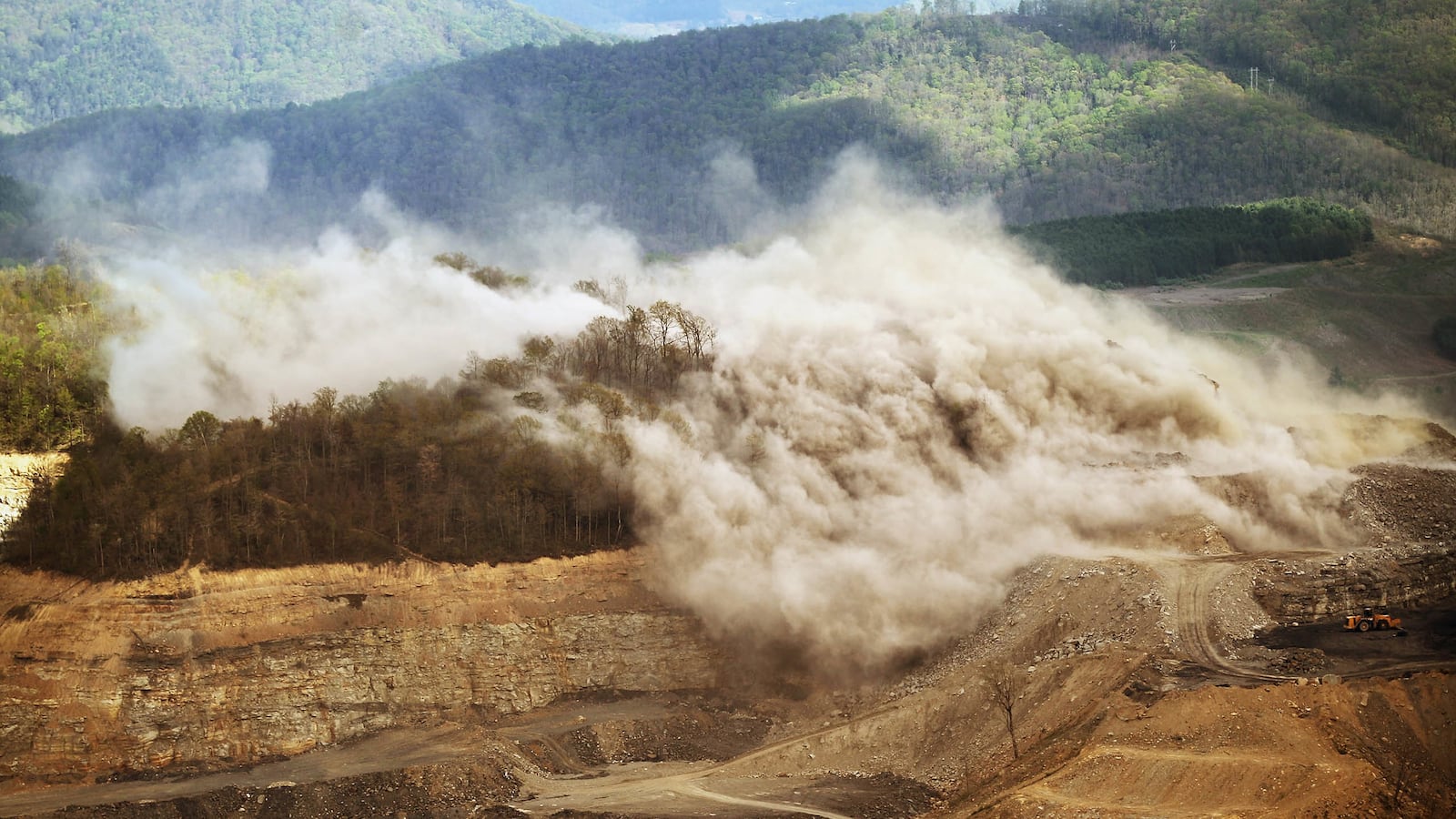The right is right: President Obama is waging a war on coal. But his fierce, regulatory-based offensive was an inevitable consequence of the GOP’s unrelenting war on the president and his climate policy. Unless the two sides sign a truce—and put meaningful energy into breakthrough cleaner coal technologies—not only will rural Appalachia be devastated in the crossfire, but our planet’s long-term health will suffer too.
****
Nestled into the Appalachian hills, hollers, and hamlets of my old Kentucky home, you’ll find a largely poor but proud people, mostly united by a passion for God, Wildcat basketball, and a simple black mineral that serves as the bedrock of the region’s sense of self. Thanks to more than a century’s worth of deep family connections to the mining vocation, as well as a brilliant decade-long public-relations campaign waged by the industry, most eastern Kentuckians share a profound emotional tie to the black rock and a jaundiced resentment toward those outsider elites who want to deprive them of their geological birthright.

So, as the coal business suffers markedly—just last week, a study revealed that Kentucky coal jobs are at their lowest level since the state started counting in 1927—most locals follow the lead of their political leadership and level their fury against President Obama’s “war on coal.” And while the resurgence of cheap natural gas is the primary factor in Appalachian coal’s declining competitiveness, there’s no question that a significant threat to the economic viability of the region has been posed by the Obama EPA’s increased regulation of coal-powered plants and mining projects (only one permit has been issued in the past three years for new or expanded surface mining in eastern Kentucky).
The good news is that a middle ground can be reached that helps boost the region’s economy while promoting energy independence and a healthier global environment: development of affordable, cutting-edge technologies that enable coal combustion with dramatically reduced greenhouse-gas emissions. The challenge is that any broad-based employment of cleaner coal solutions will require both sides of the debate to reach for common ground. And that’s a daunting prospect given our hyperpartisan, polarized system.
First, some disclosure: I’m neither a climate-change skeptic nor a shill for the industry. My first boss and mentor, Al Gore, inspired me into politics, and I was the first Kentucky gubernatorial candidate to criticize the perverse practice of mountaintop-removal mining. So while part of my passion for cleaner coal is a chauvinistic attachment to my home state, I’m more compelled by the belief that cleaner coal is an essential bridge technology to a healthier planet.
Renewable technologies have dramatically advanced in the past couple of years. But the world’s energy demand is spiraling upward: the development of our largest nations has created a nearly insatiable global appetite for cheap, reliable, and scalable base-load power.
Under the very-best-case scenario, the United States just might be able to address our energy demands and aging infrastructure with a dramatic expansion of renewables and a proliferation of natural-gas fracking.
Maybe.
But a coal-free world is an impossibility. Consider China alone: electricity demand there is expected to triple by 2035, and the Chinese will need to build the equivalent of nearly two times the entire current American generating fleet. Currently 80 percent of Chinese electricity is generated through coal; they hope to reduce that to a mere 72 percent over the next few decades. Coal is the only fuel in that region with the proven track record and established infrastructure to provide enough power in a timely manner.
The only question is if China (and don’t forget similarly situated India) will be burning coal in cleaner ways. As Atlantic columnist James Fallows summed up eloquently: “for now, the only way to meet the world’s energy needs, and to arrest climate change before it produces irreversible cataclysm, is to use coal—dirty, sooty, toxic coal—in more-sustainable ways.”
There was once—as recently as four years ago—a very prominent political proponent of cleaner coal: Barack Obama.
It may shock coal country, but its current bogeyman consistently supported measures in the U.S. Senate to provide clean-coal subsidies. Then, in his first presidential bid, Obama’s “green-jobs plan” proclaimed that he would “enter into public-private partnerships to develop five ‘first-of-a-kind’ commercial scale coal-fired plants with clean carbon-capture and sequestration technology.”
Obama’s position remained consistent in the White House. His federal stimulus package included $2.4 billion to facilitate the development of technology to reduce carbon emissions from coal-burning facilities. And in 2009, the landmark “cap and trade” bill that passed the House with Obama’s blessing included more than $60 billion earmarked for clean coal.
The latter legislation, while by no means perfect, presented a tradeoff for coal country: cap and trade would force coal plants to reduce their emissions, but the subsidies would help the industry pay for the expensive carbon-capture process.
Unfortunately, in alliance with its GOP allies who were pressing to thwart any new Obama initiative, Big Coal refused to play ball. With a few notable exceptions, the industry went all in for the status quo. Claiming that “clean coal” was an existing reality in current facilities and branding any new regulations as a war on coal (and any politician that dared to cross them as an Obama soldier), they made denying the president reelection, and his replacement with a regulation opponent, their priority No. 1.
As Rick Perry would say, “Oops.”
So, now they have their war. At the core of his new climate strategy announced in June, the president declared that he would no longer wait for legislation and would instead rely on his executive power (i.e., even stricter regulations) to cut greenhouse gases from domestic energy production. In his more than 6,000-word Georgetown speech, Obama mentioned coal twice. And never with “clean” as a modifier.
The humbled coal lobby is now suing for peace, and Democratic legislators from coal country met this month with the White House to plead their case. But their request for Obama to disarm unilaterally in his war on coal likely will fall on deaf ears in this or any future Democratic administration.
Big Coal’s best bet now is also the wisest path from a global environmental perspective: embrace cleaner coal—not simply as a marketing strategy, but as a fundamental shift in how the mineral is extracted, treated, and combusted.
Fortunately, there’s been some groundbreaking progress in cleaner-coal technology in just the past few years. The costs of Clean Coal 1.0 were prohibitively uncompetitive without a politically unpopular carbon tax driving up the cost of dirtier fuels. But after years of research and development, new processes are not only now capable of removing and capturing more than 90 percent of carbon dioxide from coal combustion; more significantly, the captured carbon is now marketable for other profitable uses. Carbon utilization can offset or even exceed, the additional cost of carbon scrubbing.
Kurt Waltzer, the managing director of the Clean Air Task Force, a nonprofit dedicated to reducing atmospheric pollution, is bullish on Clean Coal 2.0: “There is technology commercially available today that can dramatically reduce carbon emissions from burning coal.” Waltzer specifically cites the use of captured carbon in enhanced oil recovery as an existing, scalable technology that can “cut carbon emissions from the power sector by 50 percent, promote American energy independence and address serious national security concerns from importing oil.” Moreover, Waltzer assures, there are dozens, if not hundreds, of firms and entrepreneurs that are developing other, even cleaner solutions that utilize the captured carbon for fertilizer, with algae, and for the manufacturing of concrete, cement, and other construction materials. Waltzer points also to developing technologies that promote the co-gassification of coal and biomass, in which the biomass acts as a virtual scrubber of carbon in the combustion process.
Of course, any full and expeditious development of these cleaner-coal strategies would require significant financial support. And the ball is in the coal industry’s court.
So, a potential grand bargain emerges: the coal industry asks the president for a six-month moratorium on new regulations and for his promise to finally utilize an existing $8 billion fossil-fuel loan guarantee program to support cleaner coal. In turn, the industry makes a meaningful and substantial investment in Clean Coal 2.0 and helps fund efforts to diversify the Appalachian economy, preparing it for the inevitable post-coal world.
A pipe dream? Perhaps. But with all of these unlikely allies poised to benefit from cleaner coal, hopefully a few leaders will step forward, brave the demagogic nonsense, and develop a sound and sustainable path for coal country and the planet.






